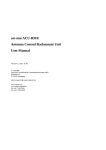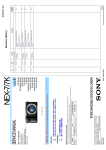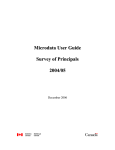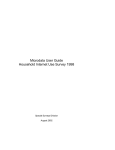Download Servo System User Manual
Transcript
VERTEX ANTENNENTECHNIK GMBH Doc.No. Version: OM1002114-21320 1.3 Table of Contents 1. Introduction ................................................................................................................. 1 1.1 Purpose of this Manual ........................................................................................... 1 1.2 Software Identification............................................................................................. 1 1.3 Acronym List ........................................................................................................... 1 2. Hexapod Kinematics ................................................................................................... 2 3. Pointing Error Model ................................................................................................... 6 3.1 Overview................................................................................................................. 6 3.1.1 3.1.2 3.2 Corrections on Jack Level....................................................................................... 7 3.2.1 3.2.2 3.2.3 3.2.4 3.2.5 3.3 Components of Pointing Error Model ...........................................................................................6 Combination of Error Terms .........................................................................................................6 Overview .......................................................................................................................................7 Jackscrew pitch error....................................................................................................................8 Temperature Compensation .......................................................................................................11 Jackscrew Rotation Error............................................................................................................12 Support Cone Compensation Mode ...........................................................................................13 Corrections on Telescope Level............................................................................ 14 3.3.1 3.3.2 3.3.3 3.3.4 3.3.5 Overview .....................................................................................................................................14 Telescope Error Model ...............................................................................................................14 RF Refraction Correction ............................................................................................................18 Misalignment of Optical Telescope.............................................................................................19 Optical Refraction Model ............................................................................................................20 page ii NOTE: THIS DOCUMENT CONTAINS PROPRIETARY INFORMATION AND MAY NOT BE DISCLOSED WITHOUT THE WRITTEN CONSENT OF VERTEX ANTENNENTECHNIK GmbH, DUISBURG VERTEX ANTENNENTECHNIK GMBH Doc.No. Version: OM1002114-21320 1.3 VERTEX ANTENNENTECHNIK GmbH CONFIDENTIAL AND PROPRIETARY All computer software, technical data or other information pertaining to the equipment covered by this document is considered proprietary by VERTEX ANTENNENTECHNIK GmbH. Such information transmitted in this document or related documents is for the benefit of VERTEX ANTENNENTECHNIK GmbH customers and is not to be disclosed to other parties verbally or in writing without prior written approval of VERTEX ANTENNENTECHNIK GmbH. Additionally, this document may not be reproduced in whole or in part without written consent from VERTEX ANTENNENTECHNIK GmbH. Update Record Release 1.2, Sep 2005 page 5: handling of mount rotation changed handling of u-joint coordinates added Release 1.3, May 2006 par. 3.1.2: par. 3.3.2: par. 3.3.3: par. 3.3.4: par. 3.3.5: description of error application in ACU modified sign definition added formula for calculation of water vapour pressure added modified formula for OPT correction new paragraph “optical refraction correction” page iii NOTE: THIS DOCUMENT CONTAINS PROPRIETARY INFORMATION AND MAY NOT BE DISCLOSED WITHOUT THE WRITTEN CONSENT OF VERTEX ANTENNENTECHNIK GmbH, DUISBURG VERTEX ANTENNENTECHNIK GMBH Doc.No. Version: OM1002114-21320 1.3 1. INTRODUCTION 1.1 Purpose of this Manual This section of the Servo System User Manual contains a description of the pointing error model of the AMiBA Hexapod Telescope at Mauna Loa, Hawaii. The pointing error model is used to eliminate known systematic pointing errors caused by non-linearities, deformations, temperature variations etc. A description of the hexapod kinematics is contained as well. The compensation algorithms themselves are implemented in the Pointing Computer (PTC). Any accessible parameters can be modified at the PTC, see part 3 of this User Manual (description of PTC Local User Interface). 1.2 Software Identification This Error Model Description describes the algorithms as implemented in the PTC software version: M1002114P-2.7. 1.3 ACU Az El EMI HPC ICD LCP LUI PCU PLC PTC STC Acronym List Antenna Control Unit Azimuth Elevation electromagnetic interference Hexapod Computer Interface Control Document Local Control Panel Local User Interface Portable Control Unit Programmable Logic Controller Pointing Computer Station Computer page 1 NOTE: THIS DOCUMENT CONTAINS PROPRIETARY INFORMATION AND MAY NOT BE DISCLOSED WITHOUT THE WRITTEN CONSENT OF VERTEX ANTENNENTECHNIK GmbH, DUISBURG VERTEX ANTENNENTECHNIK GMBH Doc.No. Version: OM1002114-21320 1.3 2. HEXAPOD KINEMATICS The kinematics of the AMiBA telescope is a mathematical optimized kinematics of a hexapod structure which is shown in Fig. 1. s Platform Center of Gravity 4 5 6 Upper Universal Joints 3 a R1 1 α1o 2 Jackscrew 1 Y’ D h 6 X’ 3 4 2 5 Z 5 4 3 α1u 6 R2 Y 2 1 Lower Universal Joints X Fig. 1: Hexapod coordinate system and mount parameters The kinematical equation of the hexapod structure is Li = (Rz(ϕ az ) ) Rx(ϕ zen ) Rz(ϕ pol ) Rz(ϕ az )T (mov i − v ) + v + dv − fix i , i = 1,...,6 with the notations ϕaz azimuth angle ϕzen zenith angle (ϕzen = π/2 - ϕel with elevation angle ϕel) ϕpol hexa-pol polarisation angle (alternatively obs-pol polarisation angle ϕpol_Obs = ϕpol - ϕaz) v vector of the rotation point D with v = (0, 0, 3580)T [mm] fix vector of the (lower) fixed point of the jackscrew with fixi = (xfi, yfi, zfi)T, i = 1,...,6 page 2 NOTE: THIS DOCUMENT CONTAINS PROPRIETARY INFORMATION AND MAY NOT BE DISCLOSED WITHOUT THE WRITTEN CONSENT OF VERTEX ANTENNENTECHNIK GmbH, DUISBURG VERTEX ANTENNENTECHNIK GMBH Doc.No. Version: OM1002114-21320 1.3 mov vector of the (upper) movable point of the jackscrew with movi = (xmi, ymi, zmi)T, i = 1,...,6 L Jackscrew length with Li, i = 1,...,6 dv1 manually pre-set translation movement (normally dv1 = (0, 0, 0)T [mm]) dv2 automatically translation movement to reduce the travel ranges of the universal joints ⎛ sin(ϕ az ) ⎞ ⎟ 90° − ϕ el [°] ⎜ dv 2(ϕ az ,ϕ zen ) = a ⎜ − cos(ϕ az ) ⎟ 90° − ϕ el ,min [°] ⎜ ⎟ 0 ⎝ ⎠ ⎛ sin(ϕ az ) ⎞ ⎟ ϕ zen ⎜ = a ⎜ − cos(ϕ az ) ⎟ θ max ⎜ ⎟ ⎝ 0 ⎠ optimized parameter : a = 850 mm, θmax = 60° dv total translation movement with dv(ϕaz,ϕzen) = dv1 + dv2(ϕaz,ϕzen) rotation matrices 0 0 ⎞ ⎛1 ⎜ ⎟ Rx(α ) := ⎜ 0 cos(α ) − sin(α ) ⎟ ⎜ 0 sin(α ) cos(α ) ⎟ ⎝ ⎠ ⎛ cos(α ) 0 sin(α ) ⎞ ⎜ ⎟ 0 1 0) ⎟ Ry (α ) := ⎜ ⎜ − sin(α ) 0 cos(α ) ⎟ ⎝ ⎠ ⎛ cos(α ) − sin(α ) 0 ⎞ ⎜ ⎟ Rz(α ) := ⎜ sin(α ) cos(α ) 0 ⎟ ⎜ 0 0 1⎟⎠ ⎝ The kinematics can be different in the forward and backward transformation. Beside the topology data the forward transformation needs the angles ϕaz, ϕzen, ϕpol and the translation movement dv1 as input data and yields the jackscrew lengths Li, i = 1,...,6, while the backward transformation needs the jackscrew lengths Li, i = 1,...,6 as input data and yields the angles ϕaz, ϕzen, ϕpol and the translation movement dv1. The global coordinate system of the AMiBA telescope together with the sky orientation is shown in Fig. 2, assuming that the mount is orientated to due North. page 3 NOTE: THIS DOCUMENT CONTAINS PROPRIETARY INFORMATION AND MAY NOT BE DISCLOSED WITHOUT THE WRITTEN CONSENT OF VERTEX ANTENNENTECHNIK GmbH, DUISBURG VERTEX ANTENNENTECHNIK GMBH Doc.No. Version: OM1002114-21320 1.3 Fig. 2: Orientation of Hexapod Mount The theoretical coordinates of the jackscrew points, which are given by an mathematical optimization calculation, are listed in Table 1. lower universal joints (variable “fix”) upper universal joints (variable “mov”) Jack x [mm] y [mm] z [mm] x [mm] y [mm] z [mm] 1 R2*cos(350°) R2*sin(350°) 0.0 R1*cos(21°) R1*sin(21°) 4620.0 2 R2*cos(70°) R2*sin(70°) 0.0 R1*cos(39°) R1*sin(39°) 4620.0 3 R2*cos(110°) R2*sin(110°) 0.0 R1*cos(141°) R1*sin(141°) 4620.0 4 R2*cos(190°) R2*sin(190°) 0.0 R1*cos(159°) R1*sin(159°) 4620.0 5 R2*cos(230°) R2*sin(230°) 0.0 R1*cos(261°) R1*sin(261°) 4620.0 6 R2*cos(310°) R2*sin(310°) 0.0 R1*cos(279°) R1*sin(279°) 4620.0 Table 1 : Theoretical jackscrew points with R1=1550.0, R2=1850.0 The real coordinates of the jackscrew points have been measured during in-plant installation of the telescope in may 2004 in Duisburg, Germany by VERTEX. As a result of fabrication tolerances the actual coordinates differ slightly from the theoretical ones. They are listed in Table 2. lower universal joints (variable “fix”) upper universal joints (variable “mov”) Jack x [mm] y [mm] z [mm] x [mm] y [mm] z [mm] 1 1822.8350 -320.5483 0.0 R1*cos(21°) R1*sin(21°) 4620.0 2 632.4422 1738.0707 0.0 R1*cos(39°) R1*sin(39°) 4620.0 3 -633.0782 1737.6624 0.0 R1*cos(141°) R1*sin(141°) 4620.0 page 4 NOTE: THIS DOCUMENT CONTAINS PROPRIETARY INFORMATION AND MAY NOT BE DISCLOSED WITHOUT THE WRITTEN CONSENT OF VERTEX ANTENNENTECHNIK GmbH, DUISBURG VERTEX ANTENNENTECHNIK GMBH Doc.No. Version: OM1002114-21320 1.3 lower universal joints (variable “fix”) upper universal joints (variable “mov”) Jack x [mm] y [mm] z [mm] x [mm] y [mm] z [mm] 4 -1823.6568 -320.3860 0.0 R1*cos(159°) R1*sin(159°) 4620.0 5 -1191.2478 -1416.5320 0.0 R1*cos(261°) R1*sin(261°) 4620.0 6 1190.9897 -1417.3090 0.0 R1*cos(279°) R1*sin(279°) 4620.0 Table 2: Actual coordinates of the jackscrew points with R1=1550.0 The mount installation on Mauna Loa differs from this symmetrical coordinates; the Az = 0 axes of the telescope as shown in Fig. 1 does not point exactly to North but is rotated by several degrees. This Azimuth offset is must be entered at ACU, HPC and PTC as a parameter. The following relationship applies: Azsky = Azmount + OffsetAz Internally, the coordinate transformations inside the three servo computer continue to use the telescope coordinate system. Commands from user or superior computer was well as position displays show the azimuth related to the “world coordinates”. The position commands are converted accordingly before being entered into the hexapod coordinate transformation: Azmount,cmd = Azsky,cmd - OffsetAz From this point of view, all azimuth angles contained in definitions and formulae earlier in this paragraph are mount related azimuth angles. The [mount related] coordinates of upper and lower u-joints are stored in an ASCII file on the CF memory cards of ACU, PTC and HPC. The coordinate files of all three computers must be identical at all times! WARNING Any significant change in coordinates, any typos or swapped digits may lead to severe damage of the telescope because collision situations could occur without being detected by software or hardware. Utmost caution is needed when modifications to the geometry file(s) are required. Such changes should only be modified by well trained and experienced staff. The manufacturer cannot be held responsible for malfunctions and/or any damage resulting from modification of the geometry file(s). page 5 NOTE: THIS DOCUMENT CONTAINS PROPRIETARY INFORMATION AND MAY NOT BE DISCLOSED WITHOUT THE WRITTEN CONSENT OF VERTEX ANTENNENTECHNIK GmbH, DUISBURG VERTEX ANTENNENTECHNIK GMBH Doc.No. Version: OM1002114-21320 1.3 3. POINTING ERROR MODEL 3.1 Overview 3.1.1 Components of Pointing Error Model The pointing error model includes the following compensations: - Compensation curves for jackscrew pitch non-linearities, based on i-plant calibration measurements for each jacks (∆Lp). - A compensation algorithm for jackscrew length variations due to temperature (∆Lt). - A compensation for non-measured length variations of a jackscrew due to rotation of the upper u-joints (∆Lr). - An algorithm calculating the shift of the lower u-joint coordinates due to distortion of the telescope base due to temperature. - A compensation algorithm for deformations of the telescope including platform depending on the actual position. This compensation is derived from error tables generated during pointing calibration measurements (∆Azerr , ∆Elerr , ∆Polerr). - A compensation algorithm for RF refraction (∆Elrefract) - A compensation algorithm for optical refraction (required only for alignment measurements using an optical pointing telescope) (∆Elrefract). - A compensation algorithm for misalignment of the optical pointing telescope (∆Azopt , ∆Elopt) The actual corrections are displayed at the PTC Local User Interface. The individual compensations can be enabled and disabled separately at the PTC Local User Interface or from remote by the station computer. 3.1.2 Combination of Error Terms The Pointing Computer will transfer the sum of all enabled corrections to the ACU, separately for jack related and telescope level corrections. ∆Ltot,i ∆Aztot ∆Eltot ∆Poltot = = = = ∆Lp,i + ∆Lt,i + ∆Lr,i ∆Azerr + ∆Azopt ∆Elerr + ∆Elopt + ∆Elrefract ∆Polerr page 6 NOTE: THIS DOCUMENT CONTAINS PROPRIETARY INFORMATION AND MAY NOT BE DISCLOSED WITHOUT THE WRITTEN CONSENT OF VERTEX ANTENNENTECHNIK GmbH, DUISBURG VERTEX ANTENNENTECHNIK GMBH Doc.No. Version: OM1002114-21320 1.3 The ACU will apply the corrections as follows: a) Actual jack length (Lact): Lact = Lmeas,i + ∆Ltot,i b) Commanded hexapod position: Azcmd_forTransformation = Azcmd_nominal - ∆Aztot Elcmd_forTransformation = Elcmd_nominal - ∆Eltot Polcmd_forTransformation = Polcmd_nominal - ∆Poltot c) Actual hexapod position: Aztrue Eltrue Poltrue = Azfrom_transformation + ∆Aztot = Elfrom_transformation + ∆Eltot = Polfrom_transformation + ∆Poltot This actual position is displayed at the ACU and reported as actual position to the STC. This means that the actual position always is the real position after applying all corrections and not the uncorrected mount position. 3.2 Corrections on Jack Level 3.2.1 Overview The corrections on jack level consist of the compensations for - jackscrew pitch error, - temperature compensation, - jack length measuring error depending on telescope position (due to rotation of upper u-joints) - support cone deformation due to temperature. All this corrections (except support cone correction) yield jack length corrections ∆L1 … ∆L6 for each of the jackscrews 1…6. On the other hand the special case effects a coordinate change of the lower universal joints which also can be interpreted as a length change of the jackscrews. All modules are described in the following chapters. page 7 NOTE: THIS DOCUMENT CONTAINS PROPRIETARY INFORMATION AND MAY NOT BE DISCLOSED WITHOUT THE WRITTEN CONSENT OF VERTEX ANTENNENTECHNIK GmbH, DUISBURG VERTEX ANTENNENTECHNIK GMBH Doc.No. Version: 3.2.2 OM1002114-21320 1.3 Jackscrew pitch error The telescope positioned is determined by measuring the positions of the six jackscrew actuators. Since not the real length of the jackscrews is measured but only the rotation, any jack pitch error (e.g. machining errors, non-linearities etc.) directly leads to a telescope positioning error. In order to be able to compensate for this error each jackscrew has undergone an in-plant calibration measurement. A correlation function (see Fig. 3) between the linear movement of the jackscrew and the encoder readout has been derived for each jackscrew. Fig. 3: Error curves for jackscrew pitch Each measurement curve in Fig. 3 can be described by a polynomial of the order 10 in the 10 form f ( x ) = ∑ ai x i . The vector a of the coefficients for each jackscrew is listed in Table 3. i =0 page 8 NOTE: THIS DOCUMENT CONTAINS PROPRIETARY INFORMATION AND MAY NOT BE DISCLOSED WITHOUT THE WRITTEN CONSENT OF VERTEX ANTENNENTECHNIK GmbH, DUISBURG VERTEX ANTENNENTECHNIK GMBH Doc.No. Version: OM1002114-21320 1.3 a jackscrew 1 a0 jackscrew 2 -2.024509761765160*10 a1 -4.690421834325520*10 a2 a3 a4 1 -2 3.175818812949300*10 -3 1.000966699300860*10 -5 1.541352099930610*10 -8 jackscrew 3 4.254599813289640*10 2 -2.015506873855310*10 -2 -1.279223138765940*10 -4 -2.079059533885010*10 -6 -6.590341383524090*10 -9 a 1 a0 -1 a1 5.333730182112170*10 -4 a2 1.767559120263330*10 -6 a3 2.504907224531590*10 -9 a4 a5 -1.424616467483780*10 -3.014122368016800*10 1.387921160762620*10 -11 -9.238622036561910*10 -12 2.285806763018910*10 -12 a6 7.764892416501680*10 -15 -7.095505201937470*10 -15 1.446531162237440*10 -15 a6 a7 2.743812116375030*10 -18 -3.198287869016120*10 -18 6.245759670530750*10 -19 a7 5.973058848219020*10 -22 -8.457849525584240*10 -22 1.714087876766300*10 -22 a8 7.325619589449050*10 -26 -1.217131472371950*10 -25 2.645713864558710*10 -26 a9 3.877049825835910*10 -30 -7.368087558944830*10 -30 1.731246066850530*10 -30 a10 a5 a8 a9 a10 a jackscrew 4 a0 jackscrew 5 2.743324175636780*10 a1 a2 a3 a4 1 1.816390007961940*10 -2 2.040482864105740*10 -3 6.306703070241420*10 -6 9.461016317632950*10 -9 8.105379713701580*10 -12 4.193397675987190*10 -15 a7 1.320217138374700*10 -18 a8 2.423328419428810*10 -22 2.285716445585560*10 -26 7.708311059986410*10 -31 a5 a6 a9 a10 jackscrew 6 -9.120596249290690*10 0 2.994017883033060*10 -2 1.853475595088450*10 -3 4.707048964999170*10 -6 5.301560895763430*10 -9 2.787891685747700*10 -12 3.403289908214870*10 -16 a -2 a0 1.399391192743870*10 -1 a1 1.296102525136170*10 -3 a2 5.695909876093460*10 -6 a3 1.109389698870550*10 -8 a4 1.187703984708340*10 -11 a5 a6 -8.464647627231470*10 7.580116027803620*10 -15 -3.342955508378500*10 -19 2.961352291320270*10 -18 a7 -1.739067723782910*10 -22 6.948301798710590*10 -22 a8 -3.372908043046730*10 -26 8.991790206208470*10 -26 a9 -2.432377395612230*10 -30 4.932382220905220*10 -30 a10 Table 3: Vector ‘a’ for each jackscrew Finally the measurement curves must shifted depending on of the real jackscrew length L [mm] and the characteristic measurement data (see Fig. 4) C1 C2 C3 C4 C5 jackscrew length, reference switch, measurement limit extended jackscrew, measurement retracted jackscrew, movement of the curve with C5 = -f(C2), so that the jackscrew pitch error can be calculated by ∆L [mm] = (f (L − C1 + C 2) + C 5 ) 10 −3 . page 9 NOTE: THIS DOCUMENT CONTAINS PROPRIETARY INFORMATION AND MAY NOT BE DISCLOSED WITHOUT THE WRITTEN CONSENT OF VERTEX ANTENNENTECHNIK GmbH, DUISBURG VERTEX ANTENNENTECHNIK GMBH Doc.No. Version: OM1002114-21320 1.3 jackscrew pitch 0 0 C4 C2 C3 x Measurement curve Fig. 4: Jackscrew with measurement curve The measurement curve is situated in the range of C4 < L-C1+C2 < C3. The data C1…C5 are listed in Table 4. Jack C1 [mm] C2 [mm] C3 [mm] C4 [mm] C5 [µm] 1 6150.366 -36.624 -19.1972 -3359.1970 14.7324 2 6149.009 -86.603 -47.7033 -3407.7029 -427.2679 3 6149.542 -38.486 -19.7907 -3359.79012 1.9514 4 6149.961 -25.151 -27.3491 -3367.3489 -28.1705 5 6150.103 -56.476 -35.8999 -3375.8999 5.6953 6 6150.360 -20.820 -17.6202 -3357.6202 2.4857 Table 4 : Correction factors for each jackscrew The coefficient vector ‘a’ is coded in the hexapod software and the correction variables C1 until C5 are stored in an external file. This file has to be replaced along with the related jackscrew if a jackscrew needs to be exchanged. The correction algorithm yields length corrections ∆Lp1 until ∆Lp6. page 10 NOTE: THIS DOCUMENT CONTAINS PROPRIETARY INFORMATION AND MAY NOT BE DISCLOSED WITHOUT THE WRITTEN CONSENT OF VERTEX ANTENNENTECHNIK GmbH, DUISBURG VERTEX ANTENNENTECHNIK GMBH Doc.No. Version: 3.2.3 OM1002114-21320 1.3 Temperature Compensation The varying temperature of the different jackscrews with the length L produces a length change ∆Lt of each jackscrew compared to the length at calibration temperature. Taking into account the material specific thermal expansion coefficient α = 12.0 * 10-6 [1/K] and the temperature difference ∆T between the individual jackscrews, which will be measured and averaged by three temperature sensors (Psens1, ∆T1), (Psens2, ∆T2), (Psens3, ∆T3) along the jackscrew (see Fig. 5), L jackscrew Psens1 Psens2 Psens3 Fig. 5: Jackscrew with temperature sensors the length change results approximately in a linear temperature characteristics function ⎧ ⎪ ⎪ ⎪ ⎪⎪ f ( x) = ⎨ ⎪ ⎪ ⎪ ⎪ ⎪⎩ to ∆Lt = ∆T 1 x ≤ Psens1 ∆T 1 Psens 2 − ∆T 2 Psens1 ∆T 2 − ∆T 1 x + Psens 2 − Psens1 Psens 2 − Psens1 ∆T 2 Psens 3 − ∆T 3 Psens 2 ∆T 3 − ∆T 2 x + Psens 3 − Psens 2 Psens 3 − Psens 2 Psens1 < x ≤ Psens 2 if x > Psens 3 ∆T 3 Psens 1 ∫α Psens 2 < x ≤ Psens 3 f ( x) dx + 0 Psens 2 ∫α Psens 1 f ( x) dx + Psens 3 ∫α f ( x) dx . Psens 2 Calibration temperature is +17°C, so ∆T = Tsens – 17°C. With the position of the sensors Psens1=122.0 mm, Psens2=1250.0 mm, Psens3=Li and the readouts of the temperatures at the sensors, the results of the module temperature correction are the correction lengths ∆Lt1 … ∆Lt6. page 11 NOTE: THIS DOCUMENT CONTAINS PROPRIETARY INFORMATION AND MAY NOT BE DISCLOSED WITHOUT THE WRITTEN CONSENT OF VERTEX ANTENNENTECHNIK GmbH, DUISBURG VERTEX ANTENNENTECHNIK GMBH Doc.No. Version: 3.2.4 OM1002114-21320 1.3 Jackscrew Rotation Error Each jackscrew spindle rotates with the angle βz (see also Fig. 6) relative to the jackscrew nut when tilting and rotating the telescope mount. Because of the spindle thread a jackscrew length change can occur which is not detected by the encoder on the still standing worm gear shaft. This influence is calculated by a mathematical algorithm derived from the kinematics of the jackscrew at any position. ß ßmx my z'' movable point y'' x'' jackscrew ßz z' y' fix point ßfx ß fy x' Fig. 6: Rotation of the jackscrew Each jackscrew kinematics consists of the five degrees of rotations βfx, βfy, βmx, βmy and βz. A special algorithm calculates the essential data βz. With a jackscrew pitch of p = 20 mm/rotation and the basis rotation angle βz,basis (is equal to βz in the hexapod basis position) the jackscrew length error by rotation of the jackscrew against the fixed nut is p . ∆Lr = (β z ,basis − β z ) 2 π The algorithm is coded in the hexapod software and the results are the correction lengths ∆Lr1 … ∆Lr6. page 12 NOTE: THIS DOCUMENT CONTAINS PROPRIETARY INFORMATION AND MAY NOT BE DISCLOSED WITHOUT THE WRITTEN CONSENT OF VERTEX ANTENNENTECHNIK GmbH, DUISBURG VERTEX ANTENNENTECHNIK GMBH Doc.No. Version: OM1002114-21320 1.3 3.2.5 Support Cone Compensation Mode The coordinates of the 6 lower (fixed) universal joints has been measured during in-plant assembly of the AMiBA Telescope in May 2004 at an ambient temperature of 17° C. The x and y coordinates vary with the temperature of the support cone. This error is taken into account by the formulae xnew = x * α * (T - T0) ynew = y * α * (T - T0) with the notations α specific thermal expansion coefficient with α = 12.0 * 10-6 [1/K], T average value of the temperature which is measured by several sensors at the cone, T0 basis measurement temperature of 17° C, x, y coordinates of the lower (fixed) universal joints (see Table 2, page 5). Together with the readout temperatures at the sensors and the original x, y coordinates of the lower universal joints at a temperature of 17° C, the results of the module support cone compensation mode are corrected x, y coordinates for the 6 lower universal joints. page 13 NOTE: THIS DOCUMENT CONTAINS PROPRIETARY INFORMATION AND MAY NOT BE DISCLOSED WITHOUT THE WRITTEN CONSENT OF VERTEX ANTENNENTECHNIK GmbH, DUISBURG VERTEX ANTENNENTECHNIK GMBH Doc.No. Version: OM1002114-21320 1.3 3.3 Corrections on Telescope Level 3.3.1 Overview The corrections on telescope level consist of the compensations for - error model for telescope and platform deformations, - compensation algorithm for RF refraction - compensation algorithm for optical refraction. All this corrections (except support cone correction) yield position corrections ∆ϕaz, ∆ϕel and ∆ϕpol. 3.3.2 Telescope Error Model The idea of the telescope correction mode is to measure the telescope position errors ∆ϕaz, ∆ϕel and ∆ϕpol at different points on the sky by astronomical observation of well known targets. All measurement points together make up a measurement grid. For positions between the data points the delta positions can be calculated by interpolation. For each data point, the hexapod position (Az, El, Pol) and the measured pointing errors (dAz, dEl, dPol) are entered into a file named inter_un.dat (see sample file in Table 5). The measurements make up an irregular grid of one sector of the sky. For a good pointing accuracy both the sector size and the number of measurements should be as large as possible. In addition, the measurements should be made at different polarisations. Definition of sign of pointing error: - Nominal position of object: (AzN | ElN | PolN) - The object has been found at (position display at ACU / PTC): (AzF | ElF | PolF) - Error to be entered into table at position measured pointing error (AzN | ElN | PolN) (AzF - AzN | ElF - ElN | PolF - PolN) page 14 NOTE: THIS DOCUMENT CONTAINS PROPRIETARY INFORMATION AND MAY NOT BE DISCLOSED WITHOUT THE WRITTEN CONSENT OF VERTEX ANTENNENTECHNIK GmbH, DUISBURG VERTEX ANTENNENTECHNIK GMBH Doc.No. Version: OM1002114-21320 1.3 Transform measurement data by an irregular grid to an regular grid ================================================================= calculation for an regular grid azimuth area [degree] 0.00 elevation area [degree] 30.00 polarisation area [degree] -25.00 360.00 90.00 10.00 measurement data, irregular grid Az El Pol 0.00000000 30.00000000 -30.00000000 20.00000000 30.00000000 -30.00000000 40.00000000 30.00000000 -30.00000000 60.00000000 30.00000000 -30.00000000 80.00000000 30.00000000 -30.00000000 160.00000000 30.00000000 -30.00000000 180.00000000 30.00000000 -30.00000000 200.00000000 30.00000000 -30.00000000 220.00000000 30.00000000 -30.00000000 100.00000000 30.00000000 -30.00000000 120.00000000 30.00000000 -30.00000000 140.00000000 30.00000000 -30.00000000 step step step 5.00 5.00 5.00 dAz 1.00000000 5.00000000 4.00000000 3.00000000 6.00000000 3.00000000 4.00000000 6.00000000 7.00000000 7.00000000 3.00000000 2.00000000 dEl 1.00000000 1.00000000 1.00000000 1.00000000 2.00000000 7.00000000 2.00000000 3.00000000 4.00000000 3.00000000 4.00000000 6.00000000 dPol 1.00000000 2.00000000 3.00000000 4.00000000 6.00000000 4.00000000 1.00000000 4.00000000 5.00000000 7.00000000 2.00000000 3.00000000 Table 5: Unsorted position measurements in file inter_un.dat The actual position for Pol in the both irregular and regular grids must always be entered as Hex-Pol (polarisation related to the hexapod mount). After the measurements are done the irregular grid must be transformed into a regular grid and the result is saved in a file named inter.dat (see sample in Table 6). The file must contain the characteristic data of the regular grid in lines 2…4 as shown in the sample file. This includes: - upper and lower limits of measured sector in Az, El and Pol - step size for regular grid in Az, El and Pol. The grid steps may be different for Az, El and Pol. The interpolation algorithm does not require a particular step size. However, the maximum number of lines in this file may not exceed 100,000. A possible mathematical algorithm to get a regular grid is known as Shepard method. It can be used as stand-alone software. This method (and of course all other mathematical methods) is only effective inside the measurement sector. Interpolations for positions outside the measurement sector may be inaccurate. Activating the telescope error model correction requires a file inter.dat. This must be saved on the disk on the PTC flash card in the same directory as the executable software. To read a new file inter.dat the PTC must be re-bootet. page 15 NOTE: THIS DOCUMENT CONTAINS PROPRIETARY INFORMATION AND MAY NOT BE DISCLOSED WITHOUT THE WRITTEN CONSENT OF VERTEX ANTENNENTECHNIK GmbH, DUISBURG VERTEX ANTENNENTECHNIK GMBH Doc.No. Version: OM1002114-21320 1.3 The correction software calculates by interpolation the position errors ∆ϕaz, ∆ϕel and ∆ϕpol as a function of the present telescope position. Therefore the regular grid has a great computer time advantage adverse the irregular grid. The linear interpolation algorithm searches the cube of the neighbouring positions in the grid which encloses the actual position, and interpolates the position errors assigned to each corner of the cube. The file inter.dat must contain identical lines for Az = 0 deg and Az = 360 deg. The telescope error model yields position corrections ∆Azerr, ∆Elerr and ∆Polerr. page 16 NOTE: THIS DOCUMENT CONTAINS PROPRIETARY INFORMATION AND MAY NOT BE DISCLOSED WITHOUT THE WRITTEN CONSENT OF VERTEX ANTENNENTECHNIK GmbH, DUISBURG VERTEX ANTENNENTECHNIK GMBH Doc.No. Version: OM1002114-21320 1.3 Calculation for an regular grid azimuth area [degree] 0.0000 elevation area [degree] 30.0000 polarisation area [degree] -25.0000 Az 0.00000000 0.00000000 0.00000000 0.00000000 0.00000000 0.00000000 0.00000000 0.00000000 0.00000000 0.00000000 0.00000000 0.00000000 0.00000000 0.00000000 0.00000000 0.00000000 0.00000000 0.00000000 El 30.00000000 30.00000000 30.00000000 30.00000000 30.00000000 30.00000000 30.00000000 30.00000000 35.00000000 35.00000000 35.00000000 35.00000000 35.00000000 35.00000000 35.00000000 35.00000000 40.00000000 40.00000000 360.0000 90.0000 10.0000 Pol -25.00000000 -20.00000000 -15.00000000 -10.00000000 -5.00000000 0.00000000 5.00000000 10.00000000 -25.00000000 -20.00000000 -15.00000000 -10.00000000 -5.00000000 0.00000000 5.00000000 10.00000000 -25.00000000 -20.00000000 step step step 5.0000 5.0000 5.0000 dAz 0.06819019 0.06818528 0.06818039 0.06817552 0.06817067 0.06816586 0.06816108 0.06815635 0.06829306 0.06828835 0.06828363 0.06827888 0.06827412 0.06826935 0.06826458 0.06825981 0.06839662 0.06839212 dEl -0.00858209 -0.00858367 -0.00858527 -0.00858688 -0.00858849 -0.00859011 -0.00859174 -0.00859336 -0.00857819 -0.00857977 -0.00858136 -0.00858296 -0.00858458 -0.00858620 -0.00858782 -0.00858946 -0.00857429 -0.00857586 dPol 0.00000000 0.00000000 0.00000000 0.00000000 0.00000000 0.00000000 0.00000000 0.00000000 0.00000000 0.00000000 0.00000000 0.00000000 0.00000000 0.00000000 0.00000000 0.00000000 0.00000000 0.00000000 .................................................................. .................................................................. .................................................................. 360.00000000 360.00000000 360.00000000 360.00000000 360.00000000 360.00000000 360.00000000 360.00000000 360.00000000 360.00000000 360.00000000 360.00000000 360.00000000 360.00000000 360.00000000 360.00000000 85.00000000 85.00000000 85.00000000 85.00000000 85.00000000 85.00000000 85.00000000 85.00000000 90.00000000 90.00000000 90.00000000 90.00000000 90.00000000 90.00000000 90.00000000 90.00000000 -25.00000000 -20.00000000 -15.00000000 -10.00000000 -5.00000000 0.00000000 5.00000000 10.00000000 -25.00000000 -20.00000000 -15.00000000 -10.00000000 -5.00000000 0.00000000 5.00000000 10.00000000 0.11690180 0.13483681 0.16171136 0.20329068 0.28139628 0.37440990 0.28172032 0.20456258 0.12713996 0.14697311 0.17562134 0.21738251 0.27689824 0.31867511 0.27740887 0.21882686 -0.00683586 -0.00670948 -0.00655411 -0.00648106 -0.00676227 -0.00703623 -0.00677584 -0.00656923 -0.00680790 -0.00664064 -0.00644921 -0.00631872 -0.00643678 -0.00665926 -0.00645507 -0.00639312 0.00000000 0.00000000 0.00000000 0.00000000 0.00000000 0.00000000 0.00000000 0.00000000 0.00000000 0.00000000 0.00000000 0.00000000 0.00000000 0.00000000 0.00000000 0.00000000 Table 6: Sample file inter.dat page 17 NOTE: THIS DOCUMENT CONTAINS PROPRIETARY INFORMATION AND MAY NOT BE DISCLOSED WITHOUT THE WRITTEN CONSENT OF VERTEX ANTENNENTECHNIK GmbH, DUISBURG VERTEX ANTENNENTECHNIK GMBH Doc.No. Version: OM1002114-21320 1.3 3.3.3 RF Refraction Correction The PTC also compensates for atmospheric radio refraction1. Enabling/disabling is possible at the PTC Local User Interface. The algorithm used is taken from 'Astrophysical Quantities', by C.W. Allen (3rd edition, page 124), and is : N ref0 ∆Elrefract = 1 - (7.8e-5 * P + 0.39 * e/T)/T = (N*N - 1)/2*N*N = ref0/tan(alt) where P e T alt atmospheric pressure in mb (hPa) water vapour pressure in mb (hPa) temperature in Kelvin altitude The correction ∆Elrefract is to be added to the true altitude to give the apparent altitude. Actual weather data can be transferred by the station computer to the PTC in order to keep the compensation as accurate as possible. Calculation of water vapour pressure (e) from relative humidity: e = RH/100 * ES ES = c0 * 10**[ c1*Tc / (c2 + Tc) ] where: 1 e RH ES Tc c0 c1 c2 = = = = = = = water vapour pressure in mb (hPa) relative humidity in % saturation pressure of water vapour in mb (hPa) temperature, deg C 6.1078 7.5 237.3 Algorithms provided by ASIAA page 18 NOTE: THIS DOCUMENT CONTAINS PROPRIETARY INFORMATION AND MAY NOT BE DISCLOSED WITHOUT THE WRITTEN CONSENT OF VERTEX ANTENNENTECHNIK GmbH, DUISBURG VERTEX ANTENNENTECHNIK GMBH Doc.No. Version: 3.3.4 OM1002114-21320 1.3 Misalignment of Optical Telescope This correction is only required during observations with the optical pointing telescope. It compensates for any misalignments of this device compared to the pointing direction of the main telescope. The (x,y,z)-right hand frame of an optical telescope is positioned on the AMiBA platform, whereas the z-axis is normal to the platform and the y-axis the reference line for ϕpol = 0 degree. With the notations Hx angle in the x-z plane (rotation around the y-axis, for small angles it points along the x-axis) Hy angle in the y-z-plane the pointing correction angles are2 ∆Az opt = Hx cos(ϕ az + ϕ pol ) + Hy sin(ϕ az + ϕ pol ) cos(ϕ el ) ∆El opt = Hy cos(ϕ az + ϕ pol ) − Hx sin(ϕ az + ϕ pol ) . The parameters Hx and Hy can be entered at the PTC Local User Interface, see part 3 of this manual. The correction algorithm yields position corrections ∆Azopt and ∆Elopt. There is no error in polarization. 2 Formula provided by ASIAA page 19 NOTE: THIS DOCUMENT CONTAINS PROPRIETARY INFORMATION AND MAY NOT BE DISCLOSED WITHOUT THE WRITTEN CONSENT OF VERTEX ANTENNENTECHNIK GmbH, DUISBURG VERTEX ANTENNENTECHNIK GMBH Doc.No. Version: 3.3.5 OM1002114-21320 1.3 Optical Refraction Model The optical refraction is required only for alignment measurements using an optical pointing telescope. During normal operation this refraction should be disabled. Enabling/disabling is only possible at the PTC Local User Interface. Correction formula: ∆Φ Re frOPT = 1.2 * TDK: PMB: ZD: 60.101 * tan( ZD ) − 0.0668 * tan 3 ( ZD ) PMB 283.15 * * (180 / pi ) * 3600 1013.2 TDK Ambient temperature [K] Atmospheric pressure [mbar] Distance from zenith [rad] = (90 degr - ΦEl) * π/180 The formula yields REF in radians. page 20 NOTE: THIS DOCUMENT CONTAINS PROPRIETARY INFORMATION AND MAY NOT BE DISCLOSED WITHOUT THE WRITTEN CONSENT OF VERTEX ANTENNENTECHNIK GmbH, DUISBURG VERTEX ANTENNENTECHNIK GMBH Doc.No. Version: OM1002114-21320 1.3 This page intentionally left blank. page 21 NOTE: THIS DOCUMENT CONTAINS PROPRIETARY INFORMATION AND MAY NOT BE DISCLOSED WITHOUT THE WRITTEN CONSENT OF VERTEX ANTENNENTECHNIK GmbH, DUISBURG

































